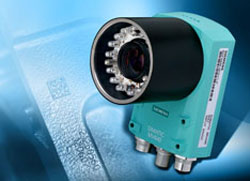New family of compact and flexible code-reading systems for industrial applications

A primary use of the compact Simatic MV440 code-reading systems, which feature high protection rating IP67, is for reading data matrix codes such as direct part marks (DPMs) on objects under difficult ambient conditions in an industrial environment.
Thanks to its flexible lighting options, the system can be adapted to the respective application. Typical uses are product tracing, process control and checking the quality of marking in a variety of applications in the automotive, packaging, pharmaceutical, tobacco, cosmetics, electronics and food&beverages industries.
Several versions of the new Simatic MV440 1D/2D code reading system are available: with integrated lighting for working at a distance of up to 80 centimeters, with external lighting and a working distance of up to three meters; with and without verification; as well as with a resolution of 640×480 or 1024×768 pixels. The Simatic MV440 reads up to 80 codes per second, reliably detecting up to fifteen types of code that have previously been stored in the device. As a result of its “multi-code reading” feature, up to 50 codes can be decoded every time an image is recorded. This is advantageous for bulk-reading of several objects that are stacked one on top of the other, for example.
One very special function is the “auto trigger”. It enables the code reader to record images permanently at maximum speed and, at the same time, to evaluate them. The reading device looks for codes in a sequence of images of any length, without the need for any external triggering signals – from a light barrier for example. This function is particularly suitable for slow-moving objects and in applications where precise triggering by a light barrier is difficult to implement. With the Simatic MV440 verifier versions, the quality of the code can be measured, making it possible to ensure that the quality of codes does not fall below a critical value over the entire production process and that, in spite of possible contamination, the codes are always detected reliably.
The Simatic MV440 has integrated interfaces to Profinet IO, Industrial Ethernet and RS232. For connection to the Profibus DP, a communication module is needed, whereby mixed operation with RFID (Radio Frequency Identification) systems connected to the same communication module is also possible. Control is carried out by means of the same function block in the Step7 program.
The Simatic MV440 code reading system is parameterized and commissioned via a built-in web server. For this purpose, the user employs a PC or a programming device with Internet Explorer installed on it. No additional software is needed. For most applications, the parameters are preset automatically. The web-based user interface provides comprehensive operator control and visualization functions, even in evaluation mode. Moreover, HMIs (Human Machine Interfaces) make it possible to display the image information.
Customized user interfaces are created with the help of visualization software, for example with Simatic WinCC or WinCC flexible. Diverse diagnostic, logging and evaluation functions are also provided. For example, time stamps, fault profiles and result values can be archived in database systems to generate trend analyses or statistics.
Media Contact
More Information:
http://www.siemens.com/simatic-sensors/mvAll latest news from the category: Corporate News
Newest articles

Decoding Cancer: 40 Years of Breakthroughs in Genetic Research
Cancer in children and adolescents is rare. Nevertheless, malignant diseases are still one of the most common causes of death in this age group. Survivors of childhood or adolescent cancer…

Let’s Think Before the First Drink: How Early Substance Use Might Lead to Brain Structure Differences Among Adolescents
Many differences appeared to exist prior to any substance use, pointing to the role brain structure may play in substance use risk, NIH-supported study suggests. Studies reveal factors that expose…

Combating Kidney Cancer Using Enhanced Immunotherapies
Medical University of South Carolina Hollings Cancer Center researcher receives Department of Defense Early Career Scholar Award to improve immune therapies by targeting resistant kidney tumors. A Medical University of…



